2014 Corvette: Techlink Article: The Return of the Stingray … The All-New 2014 Corvette Debuts
Source: GM TechLink
Date: September 5, 2013
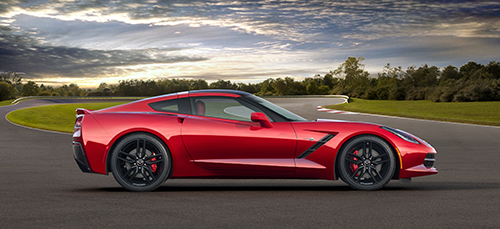
Fig 1
The all-new 2014 Corvette Stingray (C7) coupe and convertible offer a driving experience without compromise in performance, technology or design. The only carryover parts from the 2013 Corvette are the cabin air filter and the roof rear latch.
POWERTRAIN
6.2L V8 Engine (RPO LT1) ( Fig. 2)
The 2014 Corvette Stingray is the most powerful standard model ever, with 455 horsepower (339 kW) and 460 lb.-ft. of torque (623 Nm). It can accelerate from 0–60 mph in less than four seconds.
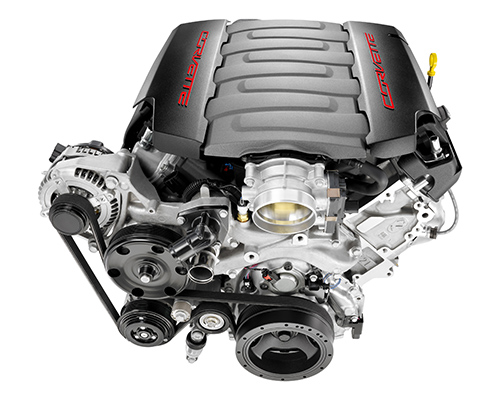
Fig 2
The engine features a cast aluminum block, cast aluminum cylinder heads with two valves per cylinder and a compression ratio of 11.5:1.
Advanced technologies include Direct Injection (DI), Active Fuel Management (AFM), Continuously Variable Valve Timing (Fig. 3) and an advanced combustion system that delivers more power while using less fuel. The recommended fuel is premium unleaded gasoline with a posted octane rating of 91 or higher.

Fig 3
Engine Oil
dexos1™ SAE 5W-30 is the best viscosity grade for the vehicle.
For cold temperature operation, below −20°F (−29 °C), SAE 0W-30 may be used.
TIP: Do not use other viscosity grade oils, such as SAE 10W-30, 10W-40, or 20W-50.
Z51 Performance Package models use the dry sump oil system.
TIP: For track events or competitive driving, Mobil 1™ 15W-50 engine oil must be used.
6-Speed 6L80 Automatic Transmission with Paddle Shift (RPO MYC)
In Manual Mode (M), the transmission can be downshifted with the left paddle and upshifted with the right paddle. The paddle shifters also can be used in Drive, but the system returns to automatic shifting after 10 seconds at a steady speed and no manual shifts, or when the vehicle comes to a stop.
Models with the automatic transmission or Z51 Performance Package feature a functional vent on the driver’s left side directing air over a heat exchanger for the transmission fluid and a similar arrangement on the passenger side that directs air over a heat exchanger for the Electronic Limited Slip Differential (ELSD) cooler.
7-Speed Tremec (TR6070) Manual Transmission with Active Rev Match (RPO MEL or MEP)
The 7-speed Tremec (TR6070) manual transmission with Active Rev Match (ARM) aids in smoother shifting by matching the engine RPM to the next selected gear. On downshifts, engine speed is increased before the clutch is engaged. On upshifts, engine speed is appropriately reduced.
The ARM system is activated and deactivated by pressing either of the REV MATCH paddles on the steering wheel. The system must be activated with each ignition cycle.
Z51 PERFORMANCE PACKAGE
The Z51 Performance Package is offered as the top performance Stingray. This package includes
• larger forged aluminum 19-inch front and 20-inch rear wheels
• dry sump oil system
• Electronic Limited Slip Differential (ELSD)
• larger front brakes (13.6-inch vs. 12.6-inch) with black calipers
• specific shocks, springs and front stabilizer bars
• differential and transmission cooling
• a unique Aero Package that reduces lift for high-speed stability
• P245/35ZR19 front and P285/30ZR20 rear Michelin Pilot Super Sport ZP summer-only tires
Magnetic Selective Ride Control and Performance Traction Management are available.
TIP: The base Corvette Stingray has a three-piece lower front air dam. The Z51 option only uses the two outer pieces and does not use the center section.
Z51 Front Tire Noise
The Michelin Pilot Super Sport ZP summer-only tires may exhibit a chatter noise during low speed tight turns when the tires are cool. The chatter typically diminishes when the tires warm up, but may increase on wet pavement. This is considered normal.
Checking Engine Oil/Dry Sump Oil Tank Noise on Startup
For an accurate reading of the dry sump lubrication system, check the oil level only after the engine has been thoroughly warmed up, after at least five minutes but no more than 15 minutes after engine shutoff.
Some customers may comment on a noise similar to running water from the dry sump oil tank when the engine is cold and started. This is a normal sound of oil returning to the tank.
Z51 Oil Filter Replacement
This engine uses a special high performance oil filter, UPF48R or equivalent. Use of any other filter may lead to filter failure and/or severe engine damage.
BRAKES
Brembo brakes (Fig. 4) are standard on the 2014 Corvette Stingray. The brakes feature an aggressive pad material for enhanced braking capability. Brake dust and some slight noise are considered normal.
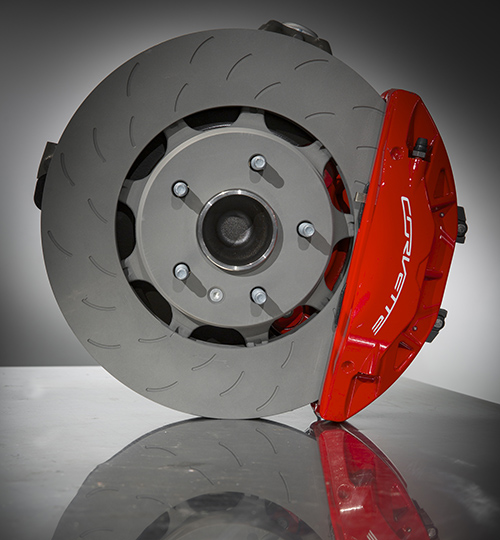
Fig 4
12.6 inch (320 mm) front rotors and 13.3 inch (338 mm) rear rotors have 35% more swept area than previous-generation brakes. This feature improves stopping distance by 9%.
Dual-cast, slotted 13.6 inch (345 mm) front rotors and 13.3 inch (338 mm) slotted rear rotors are included with the Z51 Performance Package. They are cooled front and rear for improved track capability. This feature improves stopping distance by 5%.
TIP: The Z51 Performance Package uses a two piece cast front rotor. A slight clicking or rattle noise may be heard when the brakes are applied.
SUSPENSION
The 2014 Corvette Stingray has four available suspension systems.
• Suspension System Soft Ride (RPO FE1)
• Suspension System Sport (RPO FE3)
• Suspension System Special Ride and Handling (RPO FE4, Magnetic Selective Ride Control)
The front and rear suspension feature a short/long arm (SLA) double wishbone design with cast aluminum upper and lower control arms, transverse-mounted composite springs and monotube shock absorbers. (Fig. 5)
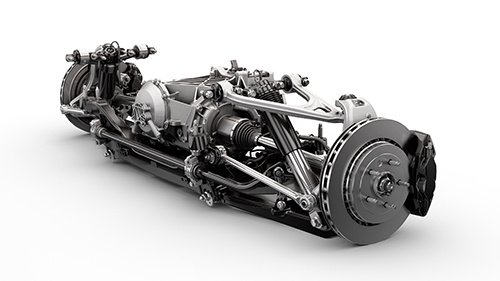
Fig 5
TIP: Cars equipped with the base suspension (RPO FE1) are not equipped with a sway bar. The holes for the attachment on the cradle are there because the cradle is a common part.
EXHAUST CONTROL SYSTEM (RPO NPP)
An exhaust tailpipe flow control valve is installed in each tailpipe in the low restriction exhaust path of the dual outlet muffler, near the exhaust tip. (Fig. 6) When the tailpipe exhaust valves are open, the low restriction exhaust path is opened to the atmosphere and the exhaust note becomes more aggressive.

Fig 6
The Chassis Control Module uses pulse width modulation to control the actuator that opens the valves. To provide a more aggressive exhaust note when the vehicle is started, the valves are opened during engine cranking. There are four specific exhaust performance modes that result in different behavior of the valves:
• Weather/Eco Mode: valves closed at all times when the engine is running.
• Tour Mode: valves closed when the engine is idling and during normal/non-aggressive driving; open during aggressive driving.
• Sport Mode: valves open when the engine is idling and during most driving scenarios.
• Track Mode: valves are open at all times.
TIP: If engine sound enhancement is turned off in the Vehicle Settings menu, the valves will be put into track mode no matter which vehicle mode is displayed on the instrument panel.
TERMINAL FUSES
The MICRO3™ fuse is the new standard for vehicle circuit protection. (Fig. 7) The MICRO3 fuse has 3 terminals and 2 fuse elements with a common center terminal. Its sub-miniature design meets the need for protecting more circuits while using less space.
The Corvette Stingray uses the MICRO3 fuses for certain circuits.

Fig 7
TIRE PRESSURE MONITOR SYSTEM
The Tire Pressure Monitor System (TPMS) Auto Learn system consists of wheel mounted sensors that transmit RF messages to an in-vehicle receiver (RFA or RCDLR) and to an Auto Learn Module. These messages are then decoded and placed on the serial data bus by the BCM so they can be displayed on Driver Information Center.
The sensors transmit whether they are located on the LH side or the RH side on the vehicle based on direction of rotation — CW or CCW.
The Auto Learn Module detects whether a sensor is located on the front axle or the rear axle, depending on the sensor signal strength.
This combination allows the system to assign IDs to the corner locations on the vehicle. The Auto Learn Module transmits these assignments to the BCM over the LIN bus. The Auto Learn function is repeated at each ignition cycle to confirm that the original sensors are still mounted to the vehicle.
If a new sensor has been installed, the system will automatically detect and assign it to the proper corner. The relearn process requires that the vehicle is driven at speeds greater than 25 mph (40 km/h) for about 10 minutes.
EXTERIOR DESIGN
The front top of the rocker molding is designed to be outboard of the bottom of the front lower door by approximately 13mm. (Fig. 8) This is a design feature and does not require adjustment.
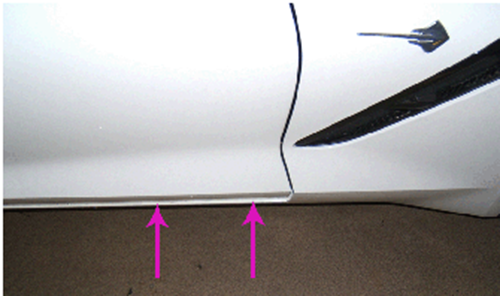
Fig 8
At the rear quarter panel, there is a clear tape-like material applied to the lower side of the rocker panels to protect against stone chips. When an object strikes this tape, it will leave a mark. The mark is not a defect. The material is there to provide some protection for the paint.
SPECIAL TOOLS
There are six new tools and six “new to division” tools* for the 2014 Corvette Stingray.

- Thanks to Art Spong and Sherman Dixon
Updated Sept. 9, 2013